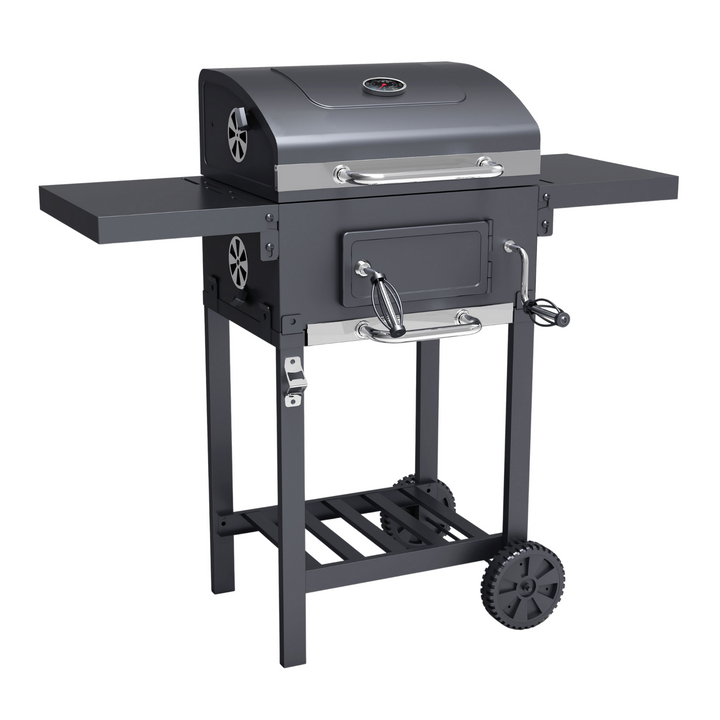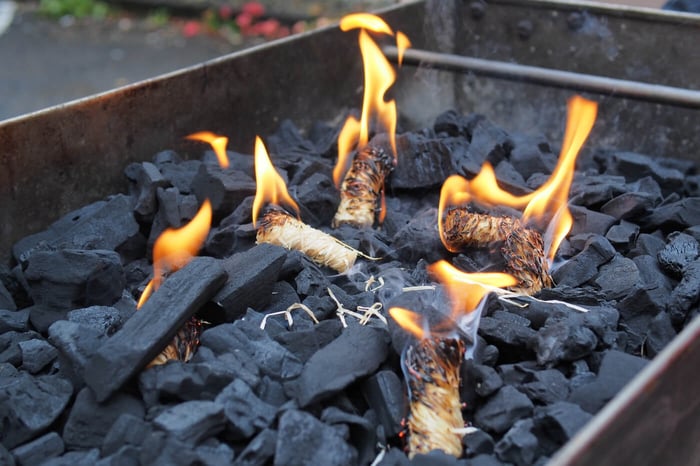Cooking enthusiasts see black charcoal differently. They don’t mind the dark stain. The authentic and smokey flavor the hot coals emit is what they’re after.
Whether for BBQ or traditional cooking (in place of a gas stove), they think of charcoal as an ingredient. All it takes is a fiery snap from a match to start a charcoal flame and then heat and grill!
Charcoal cooking is straightforward, so consider this a sign to venture this route. Although, it may require a different hands-on approach if you’re more of a gas grill fellow.
This is where this guide comes in. It covers some top ‘cooking with charcoal’ tips - suitable whether on the grill, a clay pot or a chimney. Here, you’ll learn the following:
- The types of charcoal
- How much cooking charcoal to use
- How to light coals
- How to control the heat
- When is charcoal ready to cook on
- Grilling and smoking
- Get rid of the hot charcoals
- Safety measures
Cooking with Charcoal

Charcoal is a primary cooking fuel source not only for BBQ but also in many domestic homes across the world. Its advantages are more than just the smoky flavor. And not to mention the smoke - there’s something about it that you can’t savour on burning gas.
But not all grilling or cooking charcoal is created equal. It’s important to know the various kinds so you’d know which suits the cuts of meat you wish to cook.
If you’re a novice, start with charcoal briquettes. But if you want to get more serious about it, you can have more options.
Choosing the Right Type of Charcoal
Unlike a gas grill or stove with tank propane, you have more fuel source options with charcoal cooking. These include lump charcoals, briquettes, and wood chips, to name a few. The better the quality, the better the flavour.
Let’s start with natural lump coal.
Natural lump charcoal

Natural lump coal is made from chunks of natural hardwood. There are no fillers to burn down, meaning it produces less ash than charcoal briquettes. Thanks to its high percentage of carbon, it lasts longer, burns faster and has low ash content.
Hardwood lump charcoal, for one, is used in food smokers where the hot coals need to burn for longer periods of time. In return, it adequately smokes the lean meats or fish within the smoker.
Lump charcoal is excellent for a quick, hot-and-fast grilling/smoking process.
Charcoal briquettes

Briquettes are a combination of charcoal and other ingredients moulded into easy-to-light lumps. These elements include:
- Binding agent (e.g. starch made from corn or wheat)
- Nitrate as an accelerant
- Lime as an ash-whitening agent
The binder holds the briquette together, forming into small round-cornered carbon squares. It also helps decrease the temperature at which the briquette burns. While the fillers ensure they’re easier to ignite.
In short, they aren’t actual charcoal and usually contain around 20% non-combustible materials. But they offer an even and long-burning heat, making them an ideal fuel for grilling large cuts of meat.
That also makes charcoal briquettes a popular choice, despite having higher ash residue.
Wood chips

(Image Credit: Wikimedia Commons)
Wood chips give off more intense smoke than other wood flavour enhancers. Mesquite, hickory and cherry are great examples.
To pick the best type of wood pellet for your smoking, use the meat you’re cooking as your starting point. Then decide how intense you want the flavour to pair with that meat.
Mesquite offers a strong flavour and produces an intense aroma and a savoury, spicy flavour. It pairs well with beef and other strong-flavoured meats. Whereas hickory is great for smoking beef and pork low and slow. For cherry, it pairs well with pork, chicken, and wildfowl.
Top tips: When adding on the grill or clay pot, avoid putting them directly onto the flame. Instead, place them on one side of the burning coal. The indirect heat will smoulder the chips, giving off a smokey flavour.
How Much Cooking Charcoal to Use
This depends on the food you cook or grill.
For tender eats like white fish, for instance, a quarter of a charcoal chimney will do. As for burgers and sausages, go for half to three-quarters of a charcoal chimney for medium heat. But if you’re using a grill to sear meat or cook something hot and fast, use a full chimney.
Note: Still, you’ll need a little experimentation to find the ideal ratios for your particular BBQ.
How to Light Cooking Charcoal

(Image Credit: Wikimedia Commons)
Fill the chimney to the top and rest it on a level, heat-proof surface. Or directly on the grill grates. Then, place the chimney starter, e.g. crumpled newspaper, under and light it using a match or lighter.
Allow the starter to ignite the coals and let the flames travel to the top of the chimney. Wait for all the coals to be lit and slightly ashed over. This process usually takes about 20 minutes.
Things to consider
If you’re using a grill, make sure the vents are opened. The fire will require oxygen to keep going. Once the charcoal is inside, control the temperature gauge - usually found on the vent. Don’t close the vent, or else the flames will go out.
Wider vents mean hotter flames and more oxygen. Meanwhile, smaller vents imply the opposite – a cooler cooking temperature.
How to Control the Heat
For foods that cook quickly without much risk of burning, dump the coals in the centre of the grill. Then, distribute them evenly across the lower grate. This trick works well for hot dogs, burger patties, and cut-up vegetables.
For those that require a hot sear or take a long time to cook through, build a two-zone fire. Arrange the lit coals on one half of the grill’s lower grate to create a searing surface. Plus, an indirect cooking area on the other side. Then add coals every 30 to 60 minutes to maintain the quantity you started with.
When is charcoal ready to cook?
This depends on the grill and the type of charcoal. Normally, it takes about 25 minutes to reach optimum cooking temperatures. 40 minutes for briquettes.
And to know when the charcoal is ready, wait until most of the coal has turned white/grey. That indicates the cooking charcoal is very hot on the outside and still burning on the inside.
For best results, wait for it to stop smoking. If you’re using firewood or wood chips, wait until all of it has burned up.
Note: Charcoal can stay hot from 1 hour to up to 5 or more hours.
Grilling and Smoking

There are two main types of grilling:
- Direct cooking (direct heat)
- Indirect cooking (indirect heat)
Direct grilling (direct heat) is cooking without a lid. This method is more volatile and time-consuming. It involves turning food continuously (with consistent heat) to prevent overcooking.
Indirect grilling (indirect heat), in contrast, is cooking with a lid on. It’s far more stable and less time-consuming compared to direct cooking. For one, the coals are kept at a more moderate temperature.
For adding smoke, muscle meats like pork ribs and lamb shoulder take it best. Use one to two handfuls of wood chips for every chimney of charcoal to achieve a smokey flavour.
Getting Rid of the Coals
When you’re done with the grill (or whatever cooking item you use), close the lid and shut the dampers. This will tamp down or extinguish the coals. Unburned charcoal can be transferred to a metal container and saved for future use.
Scoop the remaining ash and charcoal out of the bottom of the grill. To get rid of the embers, place them in a waterproof metal can and saturate them with water. Let them sit overnight or longer before throwing them away.
Safety Measures
Cooking with charcoal means you’re playing with fire. Set up your grill in an open space, ensure a fire extinguisher is nearby, and watch out for the kids.
Our Best Selling Smoker Charcoal Grill
Kentucky Smoker Charcoal BBQ

£132.00
£145.00
More about the Kentucky Smoker BBQ & Grill... The Kentucky smoker is an affordable option for those after traditional barbecues that can offer that classic American flavour. With a built-in thermometer and temperature gauge, you can use the crank handle… read more
Are you preparing to become a pro-level backyard pitmaster? Here, we present our best pick: the Kentucky Smoker Charcoal BBQ.
Ideal for cooking up feasts, Kentucky can provide the original BBQ taste that you may find in the best BBQ resto. With one, you can experiment with coals and wood to achieve the smokey flavour.
Keep an eye on your cooking temperature with the built-in external thermometer. And thanks to the removable ashtray, it's pretty easy to maintain.
For only £145.00, you can get yourself a worthy BBQ smoker without the fear of overcooked or undercooked food!
FAQs
Is charcoal grilling good for you?
Grilling foods can be a healthy alternative when prepared right. This includes those cooked on a charcoal barbecue grill.
Moreover, grilled foods tend to have fewer fats than cooked in a pan. For one, the meat drips the fats away, especially on the slow cooking route.
Which grill is better: charcoal or gas?
Nothing beats the aroma and smokey flavour that a charcoal BBQ grill provides. But there’s no denying how convenient gas barbecues are.
Depending on your needs, both can be beneficial. With each having its own set of pros and cons.
How do you cook with charcoal for beginners?
Listed below is the basic approach to charcoal grilling:
- Choose the types of charcoal you want to use
- Lighting the charcoal
- Decide on direct or indirect heat
- Figure out your cooking time
- Wait for the food to be cooked
- Then serve!













